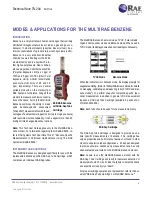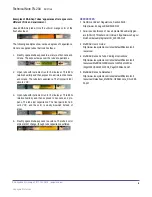
Technical Note TN-204
04/17/vk
3
Honeywell Internal
RAE Systems by Honeywell 877-723-2878 raesystems.com
Tube capacitance can be extended significantly while using the
instrument’s low pump speed (LPS) instead of its high pump
speed as default setting. Test conditions are the same as above.
Note: Previous results reinforce our strong recommendation to
only open RAE-Sep Tubes right before performing a benzene-
specific measurement. Other approaches could lead to false
positive results.
Temperature Effects
Temperature variation affects RAE-Sep Tube performance. De-
creasing temperature leads to the higher tube absorption, but slows
down chemical transformation. As a result, the tube may not show a
color change, but the tube fully or partially loses its capacitance. To
avoid confusion, follow the recommendation of “One tube, one
measurement.” Note: Calibration should be performed at the same
temperature as the measurement because time necessary for sam-
pling changes with temperature.
Tube Capacitance
Tube capacitance in this case is defined as: MultiRAE Benzene
with a RAE-Sep Tube exposed to the gases in the table for a
limited time until the reading reached 0.5 ppm.
Concentration vs. Exposure Time
Gas
Gas concentration,
ppm
Capacitance,
minutes
Toluene
100
≥10
i-Butylene
100
≥10
i-Butylene
1000
5
Methane
25000
No response
n-Hexane
2400
10 sec
n-Octane
500
1*
n-Pentane
3500
7 sec
n-Propane
11000
No response
* Reading 1 ppm after 1 minute exposure
Potential Cross-Sensitivity
Gas Cross-
sensitivity
Gas concentration,
ppm
Benzene
Response, ppm
Pentane
1700
0.1
Propane
5500
0
i-Butane
4500
0.5
i-Butylene
100
0.6
i-Butylene
1000
0.8
Methane
12500
0
Octane
250
0.3
Hexane
1200
0.6
Hexane
100
0
Butadiene 1,3
2.5
0.5
Toluene
50
1
Acetone
200
0.1
Benzene Absorption by RAE-Sep Tubes
There is a small effect of the benzene absorbtion by the RAE-
Sep Tube that potentially could slightly decrease a benzene
reading, but it doesn’t exceed 50 to 60 ppb, which is below the
instrument’s resolution of 0.1 ppm (100ppb).
0
0.5
1
1.5
2
2.5
3
3.5
4
4.5
0
2
4
6
8
Re
ad
in
g,
p
pm
Numbers of measurements
Octane, response vs. numbers
of measurements
HPS-1
LPS-1
HPS-2
LPS-2
0
50
100
150
200
250
300
110
149
225
328
Rea
ding, ppb
Benzene concentration, ppb
Effect of tube on Benzene absorption
Without tube
With tube






















